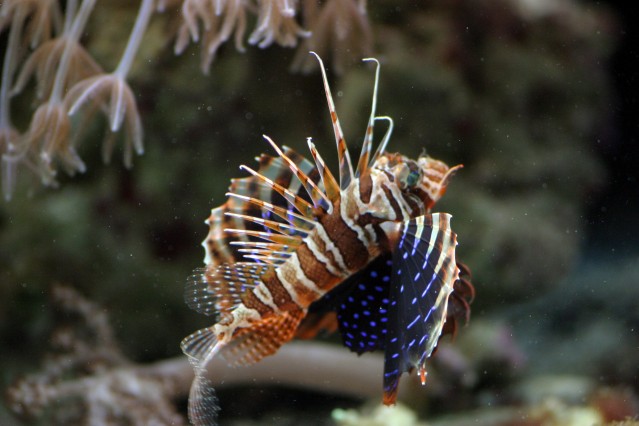The Blue-Fin/Black-Foot lionfish, Parapterois heterura, is not a common fish in the trade. Bluefin lionfish hail from the Western Pacific and South African coast, therefore, they are not collected frequently. Parapterois heterura also have a reputation for being delicate. While they are coming in with a little more frequency now, I still wish we saw them available more often. I got lucky once, and found one for sale mislabelled as a Dendrochirus zebra for $30. He was eating mysis at the store, and I thought he’d be a good candidate to keep my dwarf fuzzy lion company in an overfed 40-gallon soft coral tank.
I knew about their fragility, but the one I kept must not have read the same books. Within a week, he was eating pellets. The dwarf fuzzy was probably a good role model. The tank was a bit of a mess, but the temperature stayed around 75 degrees fahrenheit (like all my tanks). I think the cooler reef temperature helped my success. I maintained the dwarf lion tank for about a year. Both fish always ate well, and seemed to get along. I received lots of emails asking me for secret tips on my success. But really, I kept things pretty basic.
The great thing about Parapterois heterura is that their behavior is as cool as their looks. Whenever I approached the tank, the bluefin lionfish would flare his blue neon fins in a circular dance on the sand bed. It was definitely a warning sign. They clearly swam less than other lions. Bluefins are like a mixture of sedentary scorpionfish and a hovering lionfish and for this reason, I don’t think they’d do well in a tank with lots of current.
Unfortunately I lost the Bluefin lionfish to my own stupidity. The heavy feedings created an outbreak of flatworms. Late one night, I decided to dose some Flatworm Exit to clean the tank up. I had siphoned out as many flatworms as I could beforehand to reduce the toxins from a flatworm die-off. But my guess is I didn’t remove enough. The Bluefin lionfish was dead and Dwarf Fuzzy was barely hanging on. I moved the Dwarf Fuzzy over to another tank, and he recovered quickly. I guess the Parapterois heterura are indeed more delicate, especially to stupidity. But he really wasn’t that much harder to keep than any other dwarf lion.
As far as other suggestions for keeping one healthy?
- Fatten them up quick, then move them to other foods.
- Keep the temps in the low to mid 70’s with lots of O2.
- Keep the flow low. These fish come from muddy lagoons.
- Have a fine sand bed for them to bury themselves .
Hopefully we see them more often. They are simply amazing fish in person. Apparently there is quite a size difference and appearance between males and females. It is believed that the Male gets larger and more colorful. This dimorphism would make for one incredible species tank display.\








